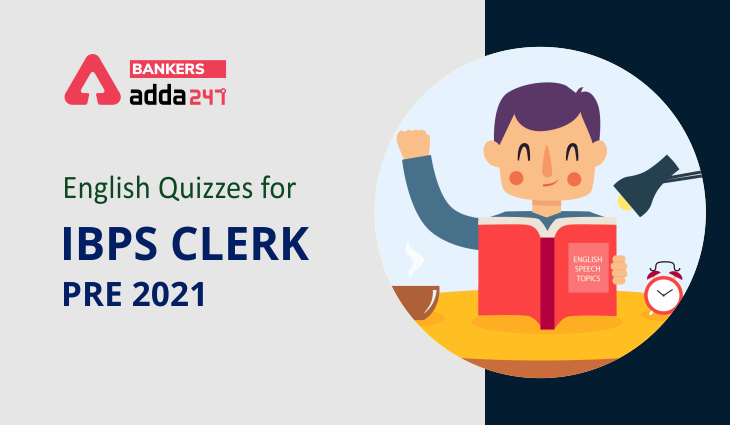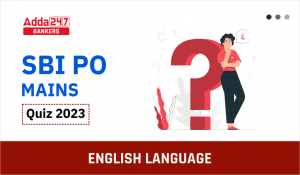
TOPIC: Error Detection
Directions (1-15): In each of the questions given below a sentence is given which is divided into 5 parts out of which one part may or may not have error in it. It is then followed by 5 options out of which one is your answer. Choose the option which gives the grammatically incorrect part as answer. If all the parts are grammatically correct, choose option (e) as the correct choice.
Q1. That apart, he would focused on creating(A)/ awareness among school students. The idea(B)/ is to approach schools and teach(C)/ students subjects such as(D)/ physics, health and civics through cycling(E).
(a) A
(b) B
(c) C
(d) D
(e) All are correct
Q2. While it was Kousalya Devi who ushered in the trend(A)/ of film adaptations of Telugu novels with Doctor Chakravarthy, it was(B)/ Sulochana’s writings that captured the fascinating of an average(C)/ reader since the ’60s reflecting contemporary(D)/ trends, relationships with her signature nostalgic style(E).
(a) A
(b) B
(c) C
(d) D
(e) No error
Q3. The novels created such an impact that(A)/ I wondered how would Yaddanapudi interprets(B)/ certain situations I witnessed(C)/ in life. She talked about very relatable(D)/ issues in contrast to feminist literature(E).
(a) A
(b) B
(c) C
(d) E
(e) No error
Q4. Her moralistic views in relationships from her(A)/ novels reflected in her real(B)/ life- she dedicated the last(C)/ few years of her life to her husband(D)/, halted her writing career(E).
(a) B
(b) C
(c) D
(d) E
(e) No error
Q5. Some months ago, a global leader of the(A)/ IT industry set sections of(B)/ India’s corporate-sector elite(C)/ aflutter of the comment(D)/ that Indians are not creative(E).
(a) A
(b) C
(c) D
(d) E
(e) No error
Q6. He traced the lack of(A)/ creativity to an education system(B)/ that rewarded(C)/ studiousness upon(D)/ independent thought(E).
(a) B
(b) C
(c) D
(d) E
(e) No error
Q7. Singapore’s orderly society may(A)/ not be everybody’s cup of tea but(B)/ its history suggests one way(C)/ we could identify the(D)/ creativity of the people as a whole(E).
(a) A
(b) B
(c) C
(d) D
(e) No error
Q8. Actually, what is India experiencing(A)/ in higher education today is(B)/ far worse than merely the(C)/ production of studious but(D) creativity-challenged youth(E).
(a) A
(b) B
(c) D
(d) E
(e) No error
Q9. To say that it has a major(A)/ responsibility for the state of affairs(B)/ that we are experiencing(C)/ in higher education would(D)/ be an understatement(E).
(a) B
(b) C
(c) D
(d) E
(e) No error
Q10. Teaching input can be(A)/ partly measured by the number(B)/ of courses taught, but research(C)/ assessment should(D)/ avoided the quantitative metric(E).
(a) B
(b) C
(c) D
(d) E
(e) No error
Q11. Introduce student evaluation of courses(A)/ to be made public. It needs(B)/ emphasis that this is meant(C)/ to be an ‘evaluation’ and not some ‘feedback’ to be(D)/ contemplated upon by the lecturer at leisure(E).
(a) A
(b) B
(c) D
(d) E
(e) No error
Q12. The present system leaves the(A)/ ability to stagnate during their(B)/ best years and the undeserving(C)/ to believe that time served(D)/ grants entitlement to promotion(E).
(a) A
(b) B
(c) C
(d) D
(e) No error
Q13. If the banks do indeed recover funds of this scale(A)/, it would considerable reduce(B)/ the burden on taxpayers(C)/, who would otherwise have(D) to foot the bill for any recapitalisation of banks(E).
(a) A
(b) B
(c) D
(d) E
(e) No error
Q14. Even most important(A)/, speedy resolution would(B)/ free valuable assets(C)/ to be used(D)/ for wealth-creation(E).
(a) A
(b) C
(c) D
(d) E
(e) No error
Q15. The resolution of one high-profile case(A)/, however, should not deflect(B)/ attention from the many(C)/ challenges still plaguing(D)/ the bankruptcy resolution process(E).
(a) A
(b) B
(c) C
(d) D
(e) No error
ALSO CHECK:
Solutions
S1. Ans.(a)
Sol. Part (A) is incorrect; ‘would’ is a modal and it should be followed by the first form of the verb according to the grammatical rule.
S2. Ans.(c)
Sol. Part (C) is incorrect; ‘fascinating’ is a verb that should be replaced by the noun ‘fascination’ to make it grammatically correct.
S3. Ans.(b)
Sol. Part (B) is incorrect; ‘interprets’ should be replaced by the ‘interpret’ as it is preceded by a modal which always takes first form of verb after it.
S4. Ans.(d)
Sol. Part (E) is incorrect; ‘halting’ will replace ‘halted’
S5. Ans.(c)
Sol. Part (D) is incorrect; ‘of’ will get replaced ‘with’
S6. Ans.(c)
Sol. Part (D) is incorrect; ‘upon’ should be replaced by ‘over’
S7. Ans.(e)
Sol. No error
S8. Ans.(a)
Sol. Part (A) is incorrect; The arrangement is grammatically incorrect as ‘is India’ will get replaced by ‘India is’
S9. Ans.(a)
Sol. Part (B) is incorrect; ‘for’ should be replaced by ‘in’
S10. Ans.(d)
Sol. Part (E) is incorrect; ‘should’ will be followed by the first form of verb .i.e. ‘avoid’
S11. Ans.(e)
Sol. No error
S12. Ans.(b)
Sol. Part (B) is incorrect; ‘able’ will replace ‘ability’ as ‘able’ is used as a noun here referring to a person.
S13. Ans.(b)
Sol. Part (B) is incorrect; ‘considerable’ will get replaced by ‘considerably’
S14. Ans.(a)
Sol. Part (A) is incorrect; ‘most’ will replace ‘more’
S15. Ans.(e)
Sol. No error
Click Here to Register for Bank Exams 2021 Preparation Material




 English Quizzes For SBI PO Mains 2023 - ...
English Quizzes For SBI PO Mains 2023 - ...








